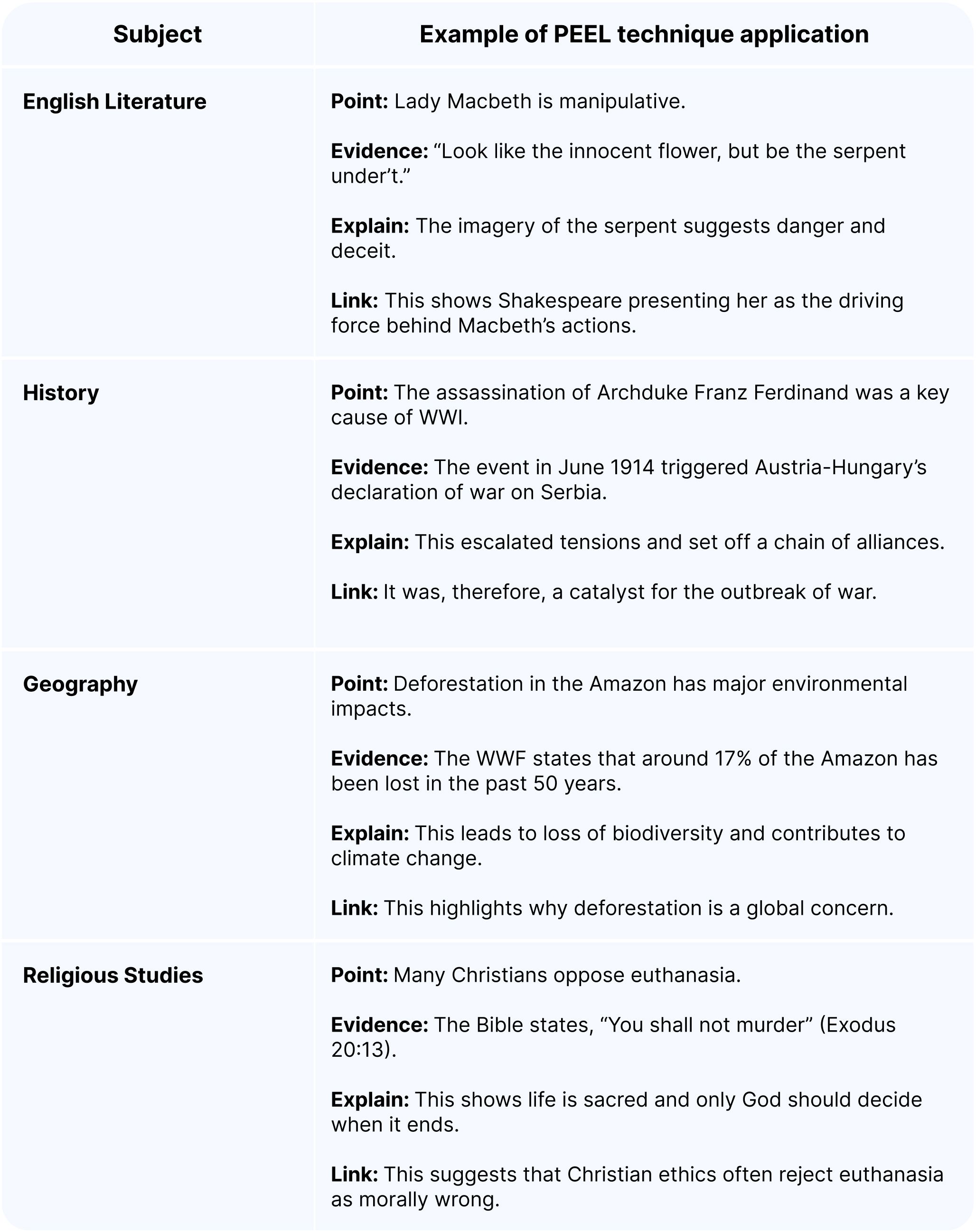Contents
Essay writing at GCSE can sometimes feel overwhelming.
How do you communicate your ideas clearly, show evidence, and stay focused on the question? The good news is that a simple structure helps: the PEEL technique.
By learning to build paragraphs this way, you can develop essays that examiners reward for being clear, well-argued, and relevant.
In this post, we’ll cover:
What the PEEL technique is and why it works
How to use the PEEL technique in essay writing for different GCSE subjects
A step-by-step guide with examples
Sample GCSE practice questions for the PEEL technique (with marks)
Tips for mastering the PEEL technique in exams and coursework
What is the PEEL technique?
The PEEL technique is a step-by-step way to build focused and persuasive paragraphs.
It stands for:
Point: Make your main argument or idea.
Evidence: Back it up with a quotation, statistic, or example.
Explain: Analyse how the evidence supports your point.
Link: Connect it back to the question or your overall argument.
Think of the PEEL technique like the scaffolding of a strong paragraph. Without it, writing can become descriptive or muddled. With it, your writing has structure and purpose.
Why the PEEL technique works for GCSE essays
Examiners are looking for writing that is focused, well-supported, and connected to the question. The PEEL technique helps you achieve that.
In English Literature, it helps you go beyond just quoting the text. You’ll explain what a quotation shows and link it back to a theme, character, or the question.
In History, answers are prevented from becoming a list of facts. Instead, you can explain why the evidence is significant and how it answers the question.
In Geography, case study material is often full of details. The PEEL technique helps you choose and link the most relevant examples to the bigger picture.
In Religious Studies, it supports balanced arguments by showing both points of view, always linked to the question.
Using the PEEL technique, you avoid vague or descriptive answers and produce structured, persuasive essays, which examiners reward with higher marks.
How to write a PEEL technique paragraph
Here’s a step-by-step example using English Literature as an example:
1. Point - State your argument clearly.
Example: Shakespeare presents Macbeth as dangerously ambitious.
2. Evidence - Provide a quotation, fact, or example.
Example: This is shown when Macbeth says, “Stars, hide your fires; Let not light see my black and deep desires.”
3. Explain - Analyse how this supports your point.
Example: The metaphor “black and deep desires” highlights his secret, destructive ambition. Shakespeare suggests that ambition can drive people to act against their morals.
4. Link - Connect back to the essay question.
Example: This demonstrates how Shakespeare explores the dangerous consequences of unchecked ambition.
Tip: Imagine a reader asking, So what? after each stage. Your job is to make sure every point, piece of evidence, and explanation is fully linked to the question and provides a clear explanation of the fact you’re trying to make. That’s the power of the PEEL technique.
Using the PEEL technique across different GCSE subjects
Here are some examples of how the PEEL technique can be used for different GCSE subjects:

Example GCSE questions to practise the PEEL technique
Here are some real-style GCSE essay questions to practise writing paragraphs with the PEEL technique. Each question includes the marks available, just like in the real exam.
English Literature (AQA example)
How does Dickens present poverty in A Christmas Carol? (30 marks + 4 marks for SPaG)*
*SPaG stands for Spelling, Punctuation and Grammar.
History (Edexcel example)
“The Treaty of Versailles was too harsh on Germany.” How far do you agree? Explain your answer. (16 marks)
Geography (OCR B example)
Evaluate the impacts of tourism in an area you have studied. (8 marks)
Religious Studies (AQA example)
“Abortion is never justified.” Discuss this statement. Give arguments for and against this view. (12 marks + 3 marks for SPaG)
How to use them:
Choose one question and write a single paragraph using the PEEL technique.
Check: Have you made a clear Point, included Evidence, given a thoughtful Explanation, and Linked back to the question?
Remember: The higher the marks, the more developed your PEEL technique paragraphs (and number of paragraphs) will need to be.
Tips for mastering the PEEL technique in essays
Building confidence with the PEEL technique takes practice.
Here are some supportive strategies:
1. Start small
Don’t jump straight into full essays. Begin by writing single PEEL technique paragraphs for practice questions.
2. Highlight your structure
Use colours to underline each stage of the PEEL technique (Point in blue, Evidence in green, etc.). This helps you check that you’ve included all parts.
3. Time yourself
In exams, PEEL technique paragraphs need to be focused and concise. Practise writing one in 7–10 minutes.
4. Use sentence starters
Point
One way this is shown is…
A key reason for this is…
The main idea here is that…
This suggests that…
Evidence
For example, …
This is demonstrated when…
In the text/source, it says…
A case study/example of this is…
Explain
This shows that…
This highlights…
The effect of this is…
This suggests that…
This means that…
This is important because…
Link
Therefore, this supports the view that…
This links back to the question because…
This connects to the wider theme of…
Overall, this demonstrates that…
Top tip: Don’t use these exact phrases in every paragraph. Think of them as training wheels; they help you get going until writing in the PEEL technique becomes natural.
5. Build flow across paragraphs
Aim for each PEEL technique paragraph to connect to the next. Phrases like Another reason is… or Similarly, this highlights… can help essays read smoothly.
Conclusion: Why the PEEL technique helps GCSE success
The PEEL technique gives you a toolkit for writing focused, well-structured essays. It works across GCSE subjects, making essay writing far less daunting with practice. Whether analysing Shakespeare, explaining a historical event, or evaluating a geography case study, the PEEL technique will help you stay clear, confident, and connected to the question.
By practising little and often, with past paper questions and short exercises, the PEEL technique can become a natural part of your writing style, helping you unlock higher marks and feel prepared for exams.
Don’t miss Atom’s GCSE giveaway!

Six months. Six epic prizes. Six chances to make the GCSE season unforgettable.
We’re launching Atom for GCSE prep in 2026, and to celebrate, over the next six months, we’re giving away thousands of pounds worth of prizes to help your child level up their GCSE revision.
Here’s a taste of what’s up for grabs:
The latest Apple tech, including an iPad Air, Vision Pro and more
Festival tickets for Boardmasters and Reading 2026
Europe interrail passes and £1,000 spending money
…and that’s just a few of the amazing prizes available.
Our first two winners have already taken home incredible prizes! Find out who they are and what they won in our latest giveaway update and keep an eye out for news of our November winner.
It’s free to join. UK only. Full T&Cs apply.
Contents
